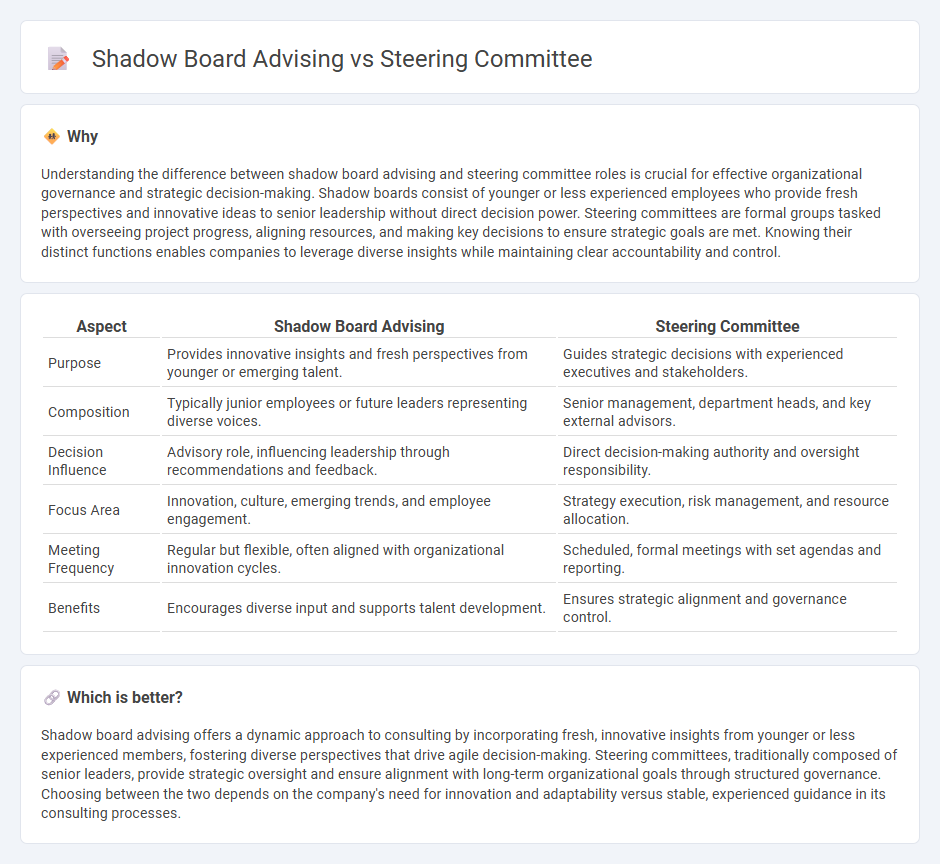
Shadow boards offer innovative consulting by engaging emerging leaders to provide fresh perspectives and agile decision-making support, contrasting with traditional steering committees that focus on governance and long-term strategic oversight. Shadow boards foster creativity and adaptability in organizational change, while steering committees ensure compliance and risk management. Explore how integrating both approaches can optimize your company's consulting outcomes.
Why it is important
Understanding the difference between shadow board advising and steering committee roles is crucial for effective organizational governance and strategic decision-making. Shadow boards consist of younger or less experienced employees who provide fresh perspectives and innovative ideas to senior leadership without direct decision power. Steering committees are formal groups tasked with overseeing project progress, aligning resources, and making key decisions to ensure strategic goals are met. Knowing their distinct functions enables companies to leverage diverse insights while maintaining clear accountability and control.
Comparison Table
| Aspect | Shadow Board Advising | Steering Committee |
|---|---|---|
| Purpose | Provides innovative insights and fresh perspectives from younger or emerging talent. | Guides strategic decisions with experienced executives and stakeholders. |
| Composition | Typically junior employees or future leaders representing diverse voices. | Senior management, department heads, and key external advisors. |
| Decision Influence | Advisory role, influencing leadership through recommendations and feedback. | Direct decision-making authority and oversight responsibility. |
| Focus Area | Innovation, culture, emerging trends, and employee engagement. | Strategy execution, risk management, and resource allocation. |
| Meeting Frequency | Regular but flexible, often aligned with organizational innovation cycles. | Scheduled, formal meetings with set agendas and reporting. |
| Benefits | Encourages diverse input and supports talent development. | Ensures strategic alignment and governance control. |
Which is better?
Shadow board advising offers a dynamic approach to consulting by incorporating fresh, innovative insights from younger or less experienced members, fostering diverse perspectives that drive agile decision-making. Steering committees, traditionally composed of senior leaders, provide strategic oversight and ensure alignment with long-term organizational goals through structured governance. Choosing between the two depends on the company's need for innovation and adaptability versus stable, experienced guidance in its consulting processes.
Connection
Shadow board advising provides real-time, innovative insights from younger executives, enhancing the Steering Committee's strategic decision-making processes. The Steering Committee relies on this advisory input to align long-term goals with emerging market trends and internal stakeholder perspectives. This collaborative dynamic ensures agile governance and effective organizational steering.
Key Terms
Governance
A steering committee typically comprises key stakeholders who guide project direction and decision-making within governance frameworks, ensuring alignment with organizational goals. Shadow boards consist of younger or non-executive members who provide fresh perspectives and innovative advice without formal decision authority, enhancing strategic governance through diverse insights. Explore how these governance models can optimize organizational oversight and drive effective decision-making.
Innovation
Steering committees provide structured oversight and strategic direction for innovation initiatives, ensuring alignment with organizational goals and resource allocation. Shadow boards consist of diverse, often younger employees who offer fresh perspectives and challenge conventional thinking to drive creative solutions. Explore how combining both can accelerate innovation and enhance decision-making processes.
Decision-making
Steering committees typically consist of senior stakeholders who guide a project by making strategic decisions and ensuring alignment with organizational goals. Shadow boards are composed of emerging leaders who provide fresh perspectives and challenge existing strategies without formal decision-making power. Explore how these advisory bodies influence organizational decision-making dynamics and drive innovation.
Source and External Links
What is a Steering Committee? (Overview, Roles, and ... - A steering committee is a group that oversees large-scale projects, sets timelines and budgets, monitors quality and risks, and defines clear project outcomes to ensure alignment with organizational goals.
What's a steering committee, and should you create one? - Steering committees provide strategic advice, set project goals and scope, create budgets and timelines, identify and mitigate risks, track success, and foster communication among stakeholders and leadership.
Steering Committee: What It Is & How to Build an Effective ... - Steering committees decide organizational priorities, manage operations, allocate resources, coordinate between units, set policies, monitor progress, and advocate for project initiatives at both project and organizational levels.
 dowidth.com
dowidth.com